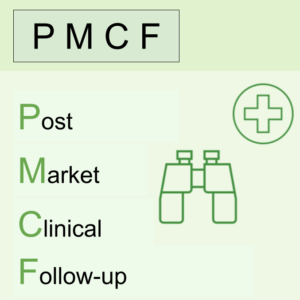PMCF: Post-Market Clinical Follow-up for Medical Devices, Guidance
Post-market clinical follow-up (PMCF) is a major regulatory requirement, aimed at updating your clinical evaluations on an ongoing basis.
The methods and expected outcomes presented below are defined in Regulation (EU) 2017/745 and associated MDCG guides.
The PMCF to consolidate clinical evaluation
The purpose of the Post-Market Clinical Follow-up is clear: to remove uncertainties around your clinical evaluation. The conclusion of your clinical evaluation is therefore the main input data to plan the PMCF, the uncertainties identified are so many avenues to define the goals of the follow-up.
Clinical follow-up will be dense in the first few years, particularly for an innovative device lacking data related to its use, security, and performance.
Once the device and its use are controlled, the need is less important, but the context may evolve, and new information could change your conclusions!
Also, the PMCF extends throughout the life cycle of the device, it considers information about the device and about the associated context.
Note that it is exceptional not to do PMCF, it is only possible if the performance and use of the device has been mastered for a long time, with equivalent devices. Conversely, for Class III or implantable MDs, you can schedule a PMCF to justify to your NB to not do a clinical investigation pre-CE.
Defining Post-Market Clinical Follow-up objectives
In the context of clinical follow-up the objectives are usual for regulatory purpose :
- Confirm the security and performance, throughout its expected lifetime;
- Monitor for side effects and contraindications;
- Identify emerging risks;
- Identify any systematic misuse;
- Identify and monitor any use cases outside intended purpose; and
- Confirm that the benefit/risk ratio remains acceptable.
And this, with clinical data.
These objectives are not specific to PMCF: they are found in the following activities (and standards):
- Security & Performance: Design and Development (ISO 13485)
- Side effects: clinical evaluation, including investigation (ISO 14155)
- New risks: Risk management (ISO 14971)
- Misuse: Usability Engineering (IEC 62366-1)
- Use outside of intended use: Usability Engineering or even outside your responsibility if it is intentional
- B/R acceptability: Benefit/risk ratio management (XP S99-223)
The PMCF is therefore the clinical tip of the PMS iceberg.
“General” PMS methods applicable to PMCF
The PMCF is a subcomponent of the PMS dedicated to clinical data, many “general” PMS methods can feed into the PMCF:
Among the general methods :
- Consultation of the scientific literature and other clinically relevant sources of literature: recommendations, standards, guides, new practices;
- Surveillance of equivalent devices;
- Collection and analysis of data from clinical experience gained;
- Collection of device use cases outside intended purpose;
- Collection and analysis of use cases of the device in the context of compassionate or humanitarian use (context where the B/R justify a use outside regulatory conformity);
- Collection and analysis of feedback data from users, both patients and professionals (including complaints, surveys);
- Analysis of data from other activities of PMS.
Post-Market Clinical Follow-up’s “specifics” methods
It may be necessary to plan a PMCF study/investigation, in addition to general activities. An obviously cumbersome decision, which will need to be managed like any clinical study.
Among the circumstances tending to make a follow-up clinical study :
- Request from the Notified Body;
- Subject to a follow-up clinical study;
- Uncertainties about risks, benefits, proper use;
- Expansion of target population.
The findings of your risk management, clinical evaluation and benefit/risk assessment activities dictate the necessities.
Among the specific methods falling under “PMCF studies”:
- Clinical investigations
- Patient cohort follow-up
- Review of registries, databases, clinical publications
- Investigations involving the human person
Expected documents in Post-Market Clinical Follow-up
To meet PMCF requirements it will be necessary to produce, for each device:
- A planning of the PMCF.
- A report of the PMCF evaluation, included in the clinical evaluation report, itself included in the technical documentation.
- The follow-up of the preventive and corrective actions decided following PMCF.
Your PMCF activities will also feed into your PSUR and SSCP. Depending on the actions decided, this monitoring may also lead to changes in the device, its use or the information provided.
Note that the PMCF plan, like the PSUR, must be self-contained documents, which can be read without any other document. They therefore contain a lot of information already present from your technical documentation, especially in the risk management file, the clinical evaluation or a list of applied reference materials.
Who does the PMCF?
This is a big difficulty with PMCF: knowing who does what.
Clinical follow-up is at the crossroads of clinical evaluation and general surveillance.
Manufacturers very often use a dedicated clinical person, and it is rare that other people in the team “speak clinical“.
Yet, PMS and PMCF start from the same needs and often involve the same sources of data.
It is crucial that the Clinical Manager raises the awareness of the team, linking the clinical need to the other activities of the company: clinical data will confirm the assumptions of the design office, remove the doubts of Software Item management, prove Usability Engineering… the PMCF will also impact the processing of customer information, which is likely to be clinical in nature.
PMCF is a multiprocess, multi-stakeholder activity, clear interactions are required.

